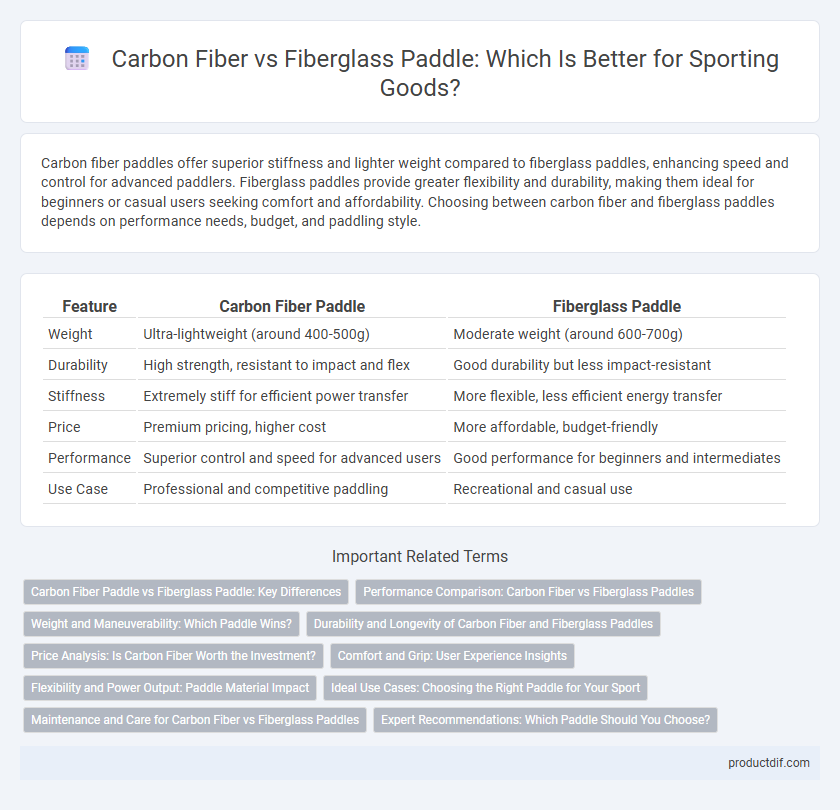Carbon fiber paddles offer superior stiffness and lighter weight compared to fiberglass paddles, enhancing speed and control for advanced paddlers. Fiberglass paddles provide greater flexibility and durability, making them ideal for beginners or casual users seeking comfort and affordability. Choosing between carbon fiber and fiberglass paddles depends on performance needs, budget, and paddling style.
Table of Comparison
| Feature | Carbon Fiber Paddle | Fiberglass Paddle |
|---|---|---|
| Weight | Ultra-lightweight (around 400-500g) | Moderate weight (around 600-700g) |
| Durability | High strength, resistant to impact and flex | Good durability but less impact-resistant |
| Stiffness | Extremely stiff for efficient power transfer | More flexible, less efficient energy transfer |
| Price | Premium pricing, higher cost | More affordable, budget-friendly |
| Performance | Superior control and speed for advanced users | Good performance for beginners and intermediates |
| Use Case | Professional and competitive paddling | Recreational and casual use |
Carbon Fiber Paddle vs Fiberglass Paddle: Key Differences
Carbon fiber paddles offer superior strength-to-weight ratio and enhanced stiffness, making them ideal for high-performance water sports requiring agility and power. Fiberglass paddles provide greater flexibility and durability at a lower cost, often preferred by recreational paddlers for comfort and resistance to impact. The choice between carbon fiber and fiberglass affects paddle responsiveness, weight, and price, with carbon fiber excelling in lightweight performance and fiberglass favored for affordability and toughness.
Performance Comparison: Carbon Fiber vs Fiberglass Paddles
Carbon fiber paddles provide superior stiffness and lightweight performance, enhancing power and reducing fatigue during extended use, while fiberglass paddles offer more flexibility and durability at a lower cost. The higher modulus of carbon fiber allows for quicker and more efficient energy transfer, making them ideal for competitive paddling. Fiberglass paddles, although slightly heavier, deliver a smoother, more forgiving feel suited for beginners and casual users.
Weight and Maneuverability: Which Paddle Wins?
Carbon fiber paddles weigh significantly less than fiberglass paddles, offering superior maneuverability and reduced fatigue during extended use. The lightweight nature of carbon fiber enhances control and responsiveness, making it ideal for quick strokes and precise movements. Fiberglass paddles, while durable, are generally heavier, resulting in less agility and slower reaction times.
Durability and Longevity of Carbon Fiber and Fiberglass Paddles
Carbon fiber paddles offer superior durability and longevity due to their high tensile strength and resistance to fatigue, making them less prone to splintering and wear over time. Fiberglass paddles, while more affordable, tend to degrade faster with exposure to UV rays and frequent impacts, resulting in reduced lifespan compared to carbon fiber models. Choosing carbon fiber paddles provides enhanced performance and extended use, especially under demanding conditions.
Price Analysis: Is Carbon Fiber Worth the Investment?
Carbon fiber paddles typically cost between $150 and $400, while fiberglass paddles range from $50 to $150, making carbon fiber a premium option. The higher price of carbon fiber paddles reflects their superior durability, reduced weight, and enhanced performance on the water, often justifying the investment for serious paddlers. Fiberglass paddles offer a budget-friendly alternative with decent strength but sacrifice some of the stiffness and responsiveness found in carbon fiber models.
Comfort and Grip: User Experience Insights
Carbon fiber paddles offer superior comfort and grip due to their lightweight design and enhanced vibration dampening properties, reducing arm fatigue during extended use. Fiberglass paddles provide a softer feel with slightly more flex, which can improve control but may result in less responsiveness and a heavier overall weight. Users often prefer carbon fiber for prolonged paddling sessions, while fiberglass paddles appeal to those valuing a cushioned grip and moderate stiffness.
Flexibility and Power Output: Paddle Material Impact
Carbon fiber paddles offer superior rigidity, resulting in enhanced power output by efficiently transferring energy with minimal flex. Fiberglass paddles provide greater flexibility, which absorbs impact for smoother strokes but may reduce overall power. Choosing between carbon fiber and fiberglass paddles depends on prioritizing maximum power or comfort during paddling.
Ideal Use Cases: Choosing the Right Paddle for Your Sport
Carbon fiber paddles excel in high-performance activities like competitive kayaking and stand-up paddleboarding due to their lightweight and superior stiffness, offering enhanced speed and control. Fiberglass paddles provide durability and flexibility favored in recreational paddling and whitewater rafting, where shock absorption and impact resistance are crucial. Selecting the right paddle depends on balancing the need for lightweight precision in racing versus the rugged endurance required in adventurous, high-impact environments.
Maintenance and Care for Carbon Fiber vs Fiberglass Paddles
Carbon fiber paddles require less maintenance due to their resistance to warping, cracking, and UV damage compared to fiberglass paddles, which are more susceptible to wear and may need regular inspections for surface cracks. Cleaning carbon fiber paddles is simple with mild soap and water, while fiberglass paddles often need gentle handling to avoid surface abrasions during cleaning. Proper storage in a cool, dry place helps extend the lifespan of both materials, but carbon fiber paddles generally offer greater durability with minimal upkeep over time.
Expert Recommendations: Which Paddle Should You Choose?
Experts recommend choosing a carbon fiber paddle for superior durability, lighter weight, and enhanced performance during extended paddling sessions. Fiberglass paddles offer a more budget-friendly option with decent strength but tend to be heavier and less responsive. For serious athletes seeking speed and efficiency, carbon fiber paddles are the preferred choice, while casual paddlers may find fiberglass paddles more suitable for recreational use.
Carbon Fiber Paddle vs Fiberglass Paddle Infographic

 productdif.com
productdif.com